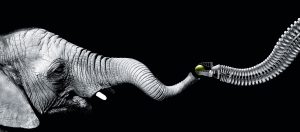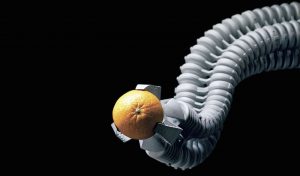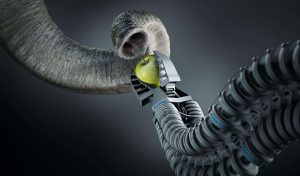A company in Germany has developed an ingenious robotic handling device based on the elephant’s trunk. Festo AG & Company promotes their “bionic handling assistant” (BHA) as being the result of their Bionic Learning Network consisting of an association with universities, institutes, and development companies.
The Festo BHA provides flexible movement and precise gripping with a structure and function that intentionally imitates an elephant’s trunk. The three photos and the video demonstrating the BHA that follow are all taken from the Festo website.
An extreme amount of engineering effort can be seen to have gone into the development of this device with its robotic controllers, sensors, control valves, and other necessary equipment. Festo says the BHA demonstrates eleven degrees of freedom* which gives it precise positioning capabilities. They continue to develop image and speech recognition abilities for the device and the BHA comes in three sizes.
The BHA is an example of the amazing things humans can invent and manufacture. But, to say the BHA has anywhere near the capabilities that God gave the elephant with its trunk is a real stretch. An actual elephant trunk has over 100,000 muscle units. With its trunk an elephant can deftly handle large as well as small items, and everything in between. I have seen elephants throw large logs around and pick up a single piece of straw. Elephants use their trunks to suck up water and dust to blow onto their backs to assist with their skin condition and hygiene. They can even dig holes in the ground with their trunks in order to find water!
As with all of the biomimicry successes that I have seen developed by man so far, God still is the superior engineer by far. It is too bad that companies like Festo continue to attribute their biomimicry successes to nature instead of to God.
J.D. Mitchell
*In engineering mechanics, “degrees of freedom” of an object represents its ability to move around in a space. A three-dimensional space has just six degrees of freedom. These are yaw, pitch, and roll for rotational movement, and elevate, straff, and surge for translational movement.





